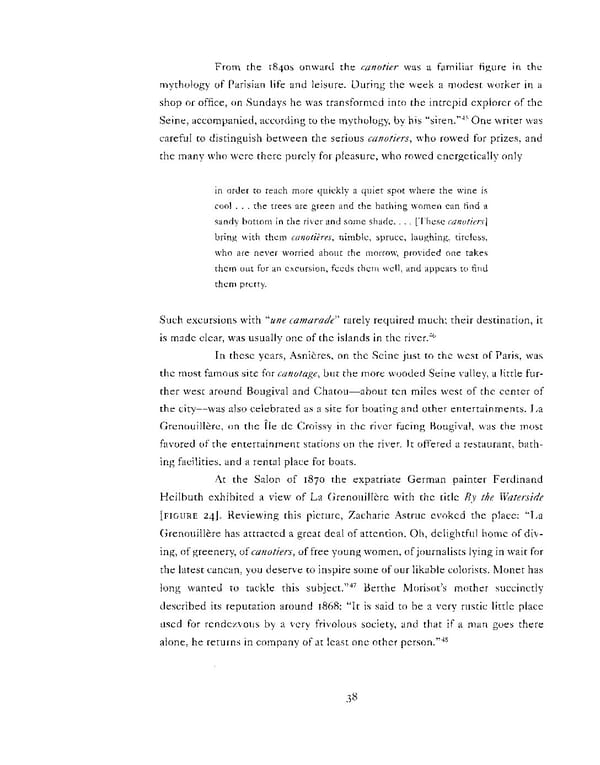From the 18405 onward the canotier was a familiar figure in the mythology of Parisian life and leisure. During the week a modest worker in a shop or office, on Sundays he was transformed into the intrepid explorer of the 45 Seine, accompanied, according to the mythology, by his "siren." One writer was careful to distinguish between the serious canotiers, who rowed for prizes, and the many who were there purely for pleasure, who rowed energetically only in order to reach more quickly a quiet spot where the wine is cool . . . the trees are green and the bathing women can find a sandy bottom in the river and some shade. . . . [These canotiers\ bring with them canotieres, nimble, spruce, laughing, tireless, who are never worried about the morrow, provided one takes them out for an excursion, feeds them well, and appears to find them pretty. Such excursions with "une camarade" rarely required much; their destination, it 46 is made clear, was usually one of the islands in the river. In these years, Asnieres, on the Seine just to the west of Paris, was the most famous site for canotage, but the more wooded Seine valley, a little fur- ther west around Bougival and Chatou—about ten miles west of the center of the city—was also celebrated as a site for boating and other entertainments. La Grenouillere, on the lie de Groissy in the river facing Bougival, was the most favored of the entertainment stations on the river. It offered a restaurant, bath- ing facilities, and a rental place for boats. At the Salon of 1870 the expatriate German painter Ferdinand Heilbuth exhibited a view of La Grenouillere with the title By the Waterside [FIGURE 24]. Reviewing this picture, Zacharie Astruc evoked the place: "La Grenouillere has attracted a great deal of attention. Oh, delightful home of div- ing, of greenery, vtcanotiers, of free young women, of journalists lying in wait for the latest cancan, you deserve to inspire some of our likable colorists. Monet has 47 long wanted to tackle this subject." Berthe Morisot's mother succinctly described its reputation around 1868: "It is said to be a very rustic little place used for rendezvous by a very frivolous society, and that if a man goes there alone, he returns in company of at least one other person."48 3«
 Pierre-Auguste Renoir: La Promenade Page 45 Page 47
Pierre-Auguste Renoir: La Promenade Page 45 Page 47